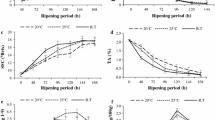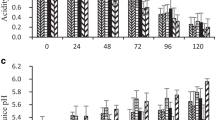Abstract
While the temporal ripening behavior of mango is widely documented, the spatial distribution with respect to physicochemical composition remains largely unknown. In this study, ripening behavior of mangos cv. Nam Dokmai was investigated focusing on the variations between the different fruit parts, namely shoulder, cheek, and tip. The temporal results showed typical ripening behavior: color changes in pericarp and mesocarp with increase of a* and b* values and rises in total soluble solids (TSS) and pH, while firmness and titratable acidity (TA) decreased. Sucrose and citric acid were respectively the predominant sugar and acid in this particular cultivar. Relating to spatial variation, the shoulder (near the stem) had the highest TSS, pH, sugar to acid ratio (TSS·TA−1), and sucrose, glucose, and fructose values. The tip showed the highest TA and citric acid content. Generally, the shoulder and tip were observed to ripen faster than cheeks. PCA was used to classify the ripeness of mango based on measured parameters and suggested that the cheek part is recommended for quality measurements. This information is imperative for the fruit handling industry, especially regarding the implementation of non-destructive technologies for quality determination.






Similar content being viewed by others
References
FAO, FAOSTAT, Rome, Italy, 2019. http://www.fao.org/faostat
B. Mahayothee, S. Neidhart, R. Carle, W. Mühlbauer, Effects of variety, ripening condition and ripening stage on the quality of sulphite-free dried mango slices. Eur. Food Res. Technol. 225, 723–732 (2007)
R.M. Salinas-Hernández, G.A. González-Aguilar, M.E. Tiznado-Hernández, Utilization of physicochemical variables developed from changes in sensory attributes and consumer acceptability to predict the shelf life of fresh-cut mango fruit. J. Food Sci. Technol. 52, 63–77 (2015)
S. Kienzle, P. Sruamsiri, R. Carle, S. Sirisakulwat, W. Spreer, S. Neidhart, Harvest maturity detection for ‘Nam Dokmai#4’ mango fruit (Mangifera indica L) in consideration of long supply chains. Postharvest Biol. Technol. 72, 64–75 (2012)
D. Sivakumar, Y. Jian, E. Yahia, Maintaining mango (Mangifera indica L.) fruit quality during the export chain. Food Res. Int. 44, 1254–1263 (2011)
M. Padda, C. do Amarante, R. Garcia, D. Slaughter, E. Mitcham, Methods to analyze physico-chemical changes during mango ripening: a multivariated approach. Postharvest Biol. Technol. 62, 267–274 (2011)
S.N. Jha, K. Narsaiah, A.D. Sharma, M. Singh, S. Bansal, R. Kumar, Quality parameters of mango and potential of non-destructive techniques for their measurement—a review. J. Food Sci. Technol. 47, 1–14 (2010)
J. Li, D. Sun, J. Cheng, Recent advances in nondestructive analytical techniques for determining the total soluble solids in fruits: a review. Compr. Rev. Food Sci. Food Saf. 15, 897–911 (2016)
P. Rungpichayapichet, B. Mahayothee, P. Khuwijitjaru, M. Nagle, J. Müller, Non-destructive determination of β-carotene content in mango by near-infrared spectroscopy compared with colorimetric measurements. J. Food Compos. Anal. 38, 32–41 (2015)
P. Rungpichayapichet, B. Mahayothee, M. Nagle, P. Khuwijitjaru, J. Müller, Robust NIRS models for non-destructive prediction of postharvest fruit ripeness and quality in mango. Postharvest Biol. Technol. 111, 31–40 (2016)
N. Wang, D. Sun, Y. Yang, H. Pu, Z. Zhu, Recent advances in the application of hyperspectral imaging for evaluation fruit quality. Food Anal. Method. 9, 178–191 (2016)
M. Nagle, K. Intani, G. Romano, B. Mahayothee, V. Sardsud, J. Müller, Determination of surface color of ‘all yellow’ mango cultivars using computer vision. Int. J. Agric. Biol. Eng. 9, 42–50 (2016)
K. Schulze, M. Nagle, W. Spreer, B. Mahayothee, J. Müller, Development and assessment of different modeling approaches for size-mass estimation of mango fruits (Mangifera indica L, cv.’Nam Dokmai’). Comput. Electron. Agric. 114, 269–276 (2015)
N. Vélez-Rivera, N. Blasco, J. Chanona-Pérez, G. Calderón-Domínguez, M. de Jesús Perea-Flores, I. Arzate-Vázquez, S. Cubero, R. Farrera-Rebollo, Computer vision system applied to classification of Manila mangoes during ripening process. Food Bioprocess Technol. 7, 1183–1194 (2014)
K.H.S. Peiris, G.G. Dull, R.G. Leffler, S.J. Kays, Spatial variability of soluble solids or dry-matter content within individual fruits, bulbs, or tubers: implications for the development and use of nir spectrometric techniques. HortScience 34, 114–118 (1999)
T. Nordey, M. Léchaudel, M. Génard, J. Joas, Spatial and temporal variations in mango colour, acidity, and sweetness in relation to temperature and ethylene gradients within the fruit. J. Plant Physiol. 171, 1555–1563 (2014)
P. Ngamchuachit, E. Mitcham, D. Barrett, Spatial variance of physicochemical properties within mangos and the effect of initial ripeness stage on the quality of fresh-cut mangos. J. Sci. Food Agric. 96, 3613–3620 (2016)
F. Liu, S. Fu, X. Bi, F. Chen, X. Liao, X. Hu, J. Wu, Physicochemical and antioxidant properties of four mango (Mangifera indica L.) cultivars in China. Food Chem. 138, 396–405 (2013)
V. Eyarkai Nambi, K. Thangavel, D. Manohar Jesudas, Scientific classification of ripening period and development of colour grade chart for Indian mangoes (Mangifera indica L.) using multivariate cluster analysis. Sci. Hortic. 193, 90–98 (2015)
A. Watanawan, C. Watanawan, J. Jarunate, Bagging ‘Nam Dok Mai #4’ mango during development affects color and fruit quality. Acta Hortic. 787, 325–328 (2008)
V. Chonhenchob, D. Kamhangwong, J. Kruenate, K. Khongrat, N. Tangchantra, U. Wichai, S.P. Singh, Preharvest bagging with wavelength-selective materials enhances development and quality of mango (Mangifera indica L.) cv. Nam Dok Mai #4. J. Sci. Food Agric. 91, 664–671 (2011)
S. Jha, A. Kingsly, S. Chopra, Physical and mechanical properties of mango during growth and storage for determination of maturity. J. Food Eng. 72, 73–76 (2006)
Y. Fuchs, E. Pesis, G. Zauberman, Changes in amylase activity, starch and sugar contents in mango fruit pulp. Sci. Hortic. 13, 155–160 (1980)
S.M. Blankenship, D.D. Ellsworth, R.L. Powell, A ripening index for banana fruit based on starch content. HortTechnology 3, 338–339 (1993)
M.S. Reid, C.A.S. Padfield, C.B. Watkins, J.E. Harman, Starch iodine pattern as a maturity index for Granny Smith apples 1. Comparison with flesh firmness and soluble solid contents. N. Z. J. Agric. Res. 25, 229–237 (1982)
V. Paul, R. Pandev, Role of internal atmosphere on fruit ripening and storability—a review. J. Food Sci. Technol. 51, 1223–1250 (2014)
M. Castrilloo, N. Kruger, F. Whatley, Sucrose metabolism in mango fruit during ripening. Plant Sci. 84, 45–51 (1992)
I. Ibarra-Garza, P. Ramos-Parra, C. Hernández-Brenes, D. Jacobo-Velázquez, Effects of postharvest ripening on the nutraceutical and physicochemical properties of mango Mangifera indica L. cv Keitt). Postharvest Biol. Technol. 103, 45–54 (2015)
A. Medlicott, A. Thompson, Analysis of sugars and organic acids in ripening mango fruits (Mangifera indica L. var Keitt) by high performance liquid chromatography. J. Sci. Food Agric. 36, 561–566 (1985)
N. Hubbard, D. Pharr, S. Huber, Role of sucrose phosphate synthase in sucrose biosynthesis in ripening bananas and its relationship to the respiratory climacteric. Plant Physiol. 94, 201–208 (1990)
F. Wang, A.G. Smith, M.L. Brenner, Temporal and spatial expression pattern of sucrose synthase during tomato fruit development. Plant Physiol. 104, 535–540 (1994)
T. Malando, R. Shewfelt, G. Ware, E. Baldwin, Sugars and acids influence flavor properties of mango (Mangifera indica). J. Am. Soc. Hortic. Sci. 126, 115–121 (2001)
J. Cruz, C. Soares, A. Fabbri, B. Cordenunsi, S. Sabato, Effect of quarantine treatments on the carbohydrate and organic acid content of mangoes (cv. Tommy Atkins). Radiat. Phys. Chem. 81, 1059–1063 (2012)
A. Medlicott, S. Reynolds, A. Thompson, Effects of temperature on the ripening of mango fruit (Mangifera indica L. var. Tommy Atkins). J. Sci. Food Agric. 37, 469–474 (1986)
H. Palafox-Carlos, E. Yahia, M. Islas-Osuna, P. Gutierrez-Martinez, M. Robles-Sánchez, G. González-Aguilar, Effect of ripeness stage of mango fruit (Mangifera indica L., cv. Ataulfo) on physiological parameters and antioxidant activity. Sci. Hortic. 135, 7–13 (2012)
B. Tavar, H.S. Barcia, M. Mata, Physiology of pre-cut mango II. Evolution of organic acids. Food Res. Int. 34, 705–714 (2001)
J. Brecht, E. Yahia, Postharvest Physiology, in The Mango, Botany, Production and Uses, ed. by R.E. Litz (CABI, London, 2009), pp. 484–528
Acknowledgements
This study was conducted within the framework of SFB 564 project T4 funded by Deutsche Forschungsgemeinschaft (DFG), Germany. The Swift Co., Ltd., Thailand as well as staff at Silpakorn University are also gratefully acknowledged for their support. The authors would like to thank the Fiat Panis foundation for providing a scholarship as well as the Food Security Center, University of Hohenheim and the DAAD (German Academic Exchange Service) for granting a visiting professorship.
Author information
Authors and Affiliations
Corresponding author
Additional information
Publisher's Note
Springer Nature remains neutral with regard to jurisdictional claims in published maps and institutional affiliations.
Rights and permissions
About this article
Cite this article
Mahayothee, B., Rungpichayapichet, P., Yuwanbun, P. et al. Temporal changes in the spatial distribution of physicochemical properties during postharvest ripening of mango fruit. Food Measure 14, 992–1001 (2020). https://doi.org/10.1007/s11694-019-00348-5
Received:
Accepted:
Published:
Issue Date:
DOI: https://doi.org/10.1007/s11694-019-00348-5




